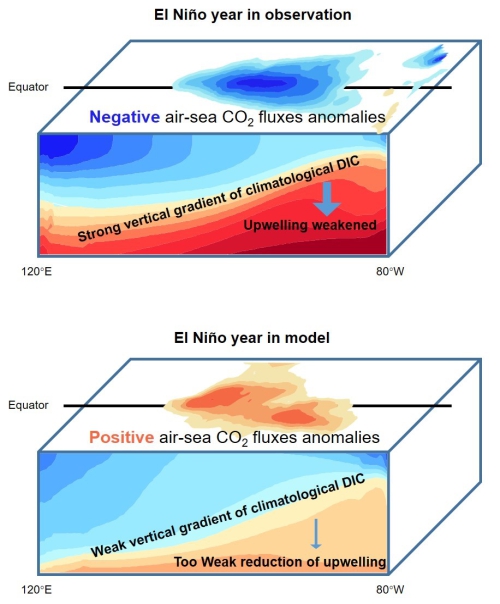
Earth system models (ESMs) are the latest generation of the state-of-the-art climate models, in which marine and terrestrial biogeochemical processes are added into coupled atmosphere–ocean general circulation models. They are powerful tools to understand and project changes in the global carbon cycle.
However, because of the nonlinear carbon cycle and climate feedbacks in ESMs, the complex coupling between biogeochemical and the physical processes can cause some unknown biases in the air–sea CO2 flux in ESMs. Therefore, it is necessary to assess their simulation skills of air–sea CO2 fluxes for the present day before using ESMs to project future climate.
Prof. ZHOU Tianjun at the Institute of Atmospheric Physics of the Chinese Academy of Sciences and the collaborators investigated the performance of ESMs in phase 5 of the Coupled Model Intercomparison Project (CMIP5) in the context of the variability of air–sea CO2 flux over the tropical Pacific related to El Nino–Southern Oscillation (ENSO) by using an emission-driven historical experiment.
The findings, published in Journal of Climate, revealed the reasons for the model biases.
Researchers showed that although the first leading mode of air-sea CO2 fluxes in the all ESMs, the same as observation-based product, is dominated by ENSO, the spatial patterns are different from and even opposite in sign to the observation in HadGEM2-ES and MPI-ESM-LR. How can people understand such an evident bias in air-sea CO2 fluxes since the ENSO variability is well simulated in these models?
It is commonly known that during El Nino, the central-eastern Pacific gets warmer and upwelling weakened. But these two processes have contrary effects on the air-sea CO2 fluxes.
By decreasing solubility and changing carbonate chemistry balance, the warmer sea surface temperature increases surface-water CO2 partial pressure and consequently the air-sea CO2 fluxes (outgassing to atmosphere). In contrast, weakened upwelling suppresses the transport of high-concentration dissolved carbon from deeper level to the surface, decreasing the surface-water CO2 partial pressure as well as the air-sea CO2 fluxes (uptaking from atmosphere). A delicate balance exists between the above two mechanisms, in which the latter should dominate the observed results.
Researchers used a linear Taylor expansion to decompose the contributions from different factors to diagnose the surface-water CO2 partial pressure biases. They found that models with large surface-water CO2 partial pressure bias generally underestimate the effect of vertical advection of dissolved inorganic carbon. Overly weak reduction of vertical motion during El Nino and weak vertical gradients of climatological dissolved inorganic carbon concentration are the main reasons for biases in the negative surface-water CO2 partial pressure and air-sea CO2 fluxes anomalies.
"To make future projection more reliable, model skills in both physical ocean responses to El Nino and climatological distributions of biogeochemical-related tracers in the present day should be improved," Dr. JIN Chenxi, the leading author of this study, suggested.

Opposite to observation (top), too weak reduction of upwelling and weak vertical gradient of climatological dissolved inorganic carbon (DIC) along the equatorial Pacific lead to positive air-sea CO2 fluxes anomalies during El Nino in some Earth system models (bottom). (Image by Prof. ZHOU's team)

86-10-68597521 (day)
86-10-68597289 (night)

86-10-68511095 (day)
86-10-68512458 (night)

cas_en@cas.cn

52 Sanlihe Rd., Xicheng District,
Beijing, China (100864)

